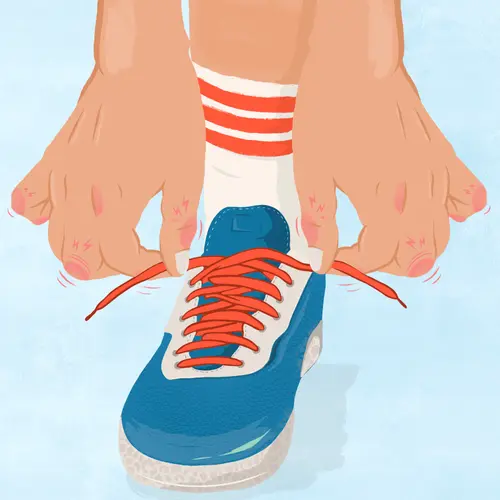Rheumatoid arthritis (RA) can lead to a metabolic state called rheumatoid cachexia, or muscle wasting. This form of cachexia happens when your body loses muscle mass and keeps fat mass. Your body develops this condition due to chronic inflammation and lack of physical activity from RA. Rheumatoid cachexia is common in people with RA. Experts believe that it might affect about two-thirds of people with RA.
Classic cachexia refers to severe weight loss when you aren’t trying and muscle loss as well. It can happen with many other conditions including cancer, chronic heart failure, chronic renal failure, chronic obstructive pulmonary disease (COPD), AIDS, and rarely with RA.
People with cachexia are usually thin and may look weak. But when you have RA, the constant inflammation that leads to muscle loss could cause you to appear overweight instead.
Since cachexia with RA tends to look different than it does with other conditions, experts call the specific form rheumatoid cachexia.
What Are the Symptoms of Rheumatoid Cachexia?
Your RA symptoms might get worse. You could also notice muscle weakness and find that it’s harder to perform everyday tasks. Your doctor might also tell you that you have:
A higher resting energy expenditure (REE). This is the energy or calories you use during 24 hours when you aren’t active.
Quicker whole-body protein catabolism. This means your body is breaking protein down into amino acids faster than it did before.
Higher levels of inflammatory cytokines (proteins), which are part of your immune response. Tumor necrosis factor-alpha not only causes inflammation, it also helps coordinate the process. Interleukin-1beta plays a role in controlling inflammation too, and can make joint damage worse when you have a disease like RA.
Sarcopenia. This syndrome results in a loss of skeletal muscle mass and strength. It puts you more at risk for a poor quality of life, physical disability, and death. Rheumatoid cachexia may explain why so many people with RA have sarcopenia.
What Causes Rheumatoid Cachexia?
Experts don’t know the exact causes of rheumatoid cachexia. But they believe that many factors may lead to the condition. These include your body’s:
- Cytokines
- Energy expenditure
- Protein metabolism
- Physical activity level
- Hormones
In addition, with RA, you don’t tend to be as active due to joint pain and stiffness and metabolic changes that lead to loss of muscle and strength. Lack of physical activity can also play a role in your development of rheumatoid cachexia.
How Do Doctors Diagnose Rheumatoid Cachexia?
Your medical team will assess your body composition to tell if you have cachexia. They’ll measure your muscle mass and fat mass. To do this, they’ll usually use:
Bioimpedance analysis (BIA). This tool can help measure your body’s fat-free mass. This term mainly refers to your body’s muscle mass.
Dual-energy X-ray absorptiometry (DEXA). With DEXA, your doctor can find your body’s lean body mass (LBM), which includes organs, skin, bone, and muscle mass
They may also use imaging tests like CT scan and MRI. And they’ll take basic measurements, like your height, weight, and body mass index (BMI). You may hear these called anthropometric measurements.
There isn’t a unified list of factors to diagnose rheumatoid cachexia. Different doctors use separate criteria to determine if you have the condition.
But generally, for your doctor to diagnose you with rheumatoid cachexia, they must find that you:
- Have RA
- Either have kept the same or have a higher body weight
- Have a fat-free mass index below the 10th percentile and a fat mass index above the 25th percentile
Your doctor may also find that you have pre-cachexia. If your doctor diagnoses you with pre-cachexia, it means you showed all four features of that condition:
- An underlying chronic disease
- Losing weight without trying -- dropping 5% or less of your body weight during the last 6 months
- Chronic or repeated inflammation
- Symptoms of appetite loss or anorexia
How Do Doctors Treat Rheumatoid Cachexia?
Proper RA treatment may help inflammation, but it tends to not have any helpful effects on rheumatoid cachexia. Even if your RA disease severity goes down and your joint inflammation gets better, rheumatoid cachexia may continue or get worse.
Doctors believe that cachexia may lead to a higher risk of death. To prevent this, early action is important.
There isn’t a standard treatment for rheumatoid cachexia. But experts believe that exercise is the best way to combat the condition. It’s important to include a combination of skeletal muscle strength training and aerobic exercise. Your doctor will create a workout plan specific to your overall health, disease status, and safety concerns.
Your doctor may also tweak your diet to help with rheumatoid cachexia. Experts suggest a Mediterranean diet alongside omega-3, vitamin D, and antioxidant supplements.

